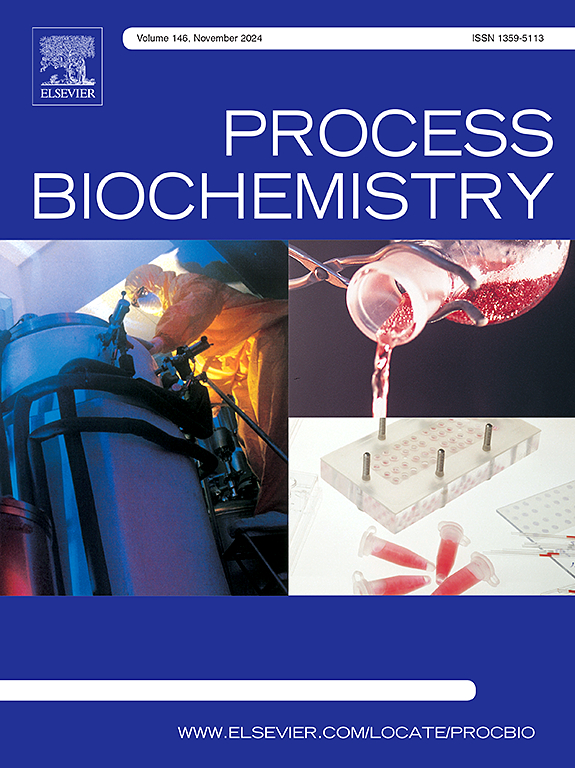Ultrasound-assisted deep eutectic solvent extraction of flavonoids from Hippophae plants: Optimization and α-glucosidase inhibition studies
IF 3.7
3区 生物学
Q2 BIOCHEMISTRY & MOLECULAR BIOLOGY
引用次数: 0
Abstract
To make full use of Hippophae plant resources, we use the green extraction method of deep eutectic solvent (DES) combined with ultrasonication to extract flavonoids. HPLC was used to measure four flavonoids (isorhamnetin-3-O-glucoside-7-O-rhamnoside, rutin, isorhamnetin-3-O-rutinoside, and isorhamnetin) in fruit samples and five flavonoids (quercetin-7-O-glucoside, isorhamnetin-3-O-glucoside-7-O-rhamnoside, rutin, guaijaverin, and kaempferol-3-O-rutinoside) in leaf samples. The best solvent was chosen from 12 kinds of DES. With betaine/acetic acid (molar ratio of 1:2) as the extraction solvent, a liquid-solid ratio of 21:1 (mL/g), an extraction temperature of 37 °C, and an extraction time of 22 min, the total content of four flavonoids in the fruit was 10.547 mg/g. With L-proline/levulinic acid (molar ratio of 1:2) as the extraction solvent, a liquid-solid ratio of 31:1 (mL/g), an extraction temperature of 49 °C, and an extraction time of 22 min, the yield of five flavonoids in the leaves was 17.921 mg/g. The extraction efficiency of this method was significantly better than that of hot reflux extraction and 60 % ethanol extraction (p < 0.05). The flavonoids obtained by further purification of the extracts from the fruit and leaves exhibited inhibitory ability to α-glucosidase in vitro, IC50 = 28.189 and 19.675 μg/mL, respectively. Above all, the use of optimized DES could efficiently extract flavonoids from Hippophae plants, which have promising applications in the regulation of blood glucose.
超声辅助深共晶溶剂提取马甲黄酮:优化及α-葡萄糖苷酶抑制研究
为充分利用沙棘属植物资源,采用深共溶溶剂(DES)绿色萃取法结合超声波法提取黄酮类化合物。采用高效液相色谱法测定水果样品中的4种黄酮类化合物(异鼠李素-3- o -葡萄糖苷-7- o -鼠李糖苷、芦丁、异鼠李素-3- o -芦丁糖苷、异鼠李素-3- o -李李糖苷)和叶子样品中的5种黄酮类化合物(槲皮素-7- o -葡萄糖苷、异鼠李素-3- o -葡萄糖苷-7- o -鼠李糖苷)。从12种DES中选择最佳提取溶剂,以甜菜碱/乙酸(摩尔比1:2)为提取溶剂,液料比21:1 (mL/g),提取温度37℃,提取时间22 min,可得到四种黄酮类化合物的总含量为10.547 mg/g。以l -脯氨酸/乙酰丙酸(摩尔比为1:2)为提取溶剂,液料比为31:1 (mL/g),提取温度为49℃,提取时间为22 min,叶中5种黄酮类化合物得率为17.921 mg/g。该方法的提取效率显著优于热回流提取法和60% %乙醇提取法(p <; 0.05)。进一步纯化得到的黄酮类化合物对α-葡萄糖苷酶具有抑制作用,IC50分别为 28.189和19.675 μg/mL。综上所述,利用优化后的DES可以有效地从沙棘植物中提取黄酮类化合物,在调节血糖方面具有广阔的应用前景。
本文章由计算机程序翻译,如有差异,请以英文原文为准。
求助全文
约1分钟内获得全文
求助全文
来源期刊

Process Biochemistry
生物-工程:化工
CiteScore
8.30
自引率
4.50%
发文量
374
审稿时长
53 days
期刊介绍:
Process Biochemistry is an application-orientated research journal devoted to reporting advances with originality and novelty, in the science and technology of the processes involving bioactive molecules and living organisms. These processes concern the production of useful metabolites or materials, or the removal of toxic compounds using tools and methods of current biology and engineering. Its main areas of interest include novel bioprocesses and enabling technologies (such as nanobiotechnology, tissue engineering, directed evolution, metabolic engineering, systems biology, and synthetic biology) applicable in food (nutraceutical), healthcare (medical, pharmaceutical, cosmetic), energy (biofuels), environmental, and biorefinery industries and their underlying biological and engineering principles.
 求助内容:
求助内容: 应助结果提醒方式:
应助结果提醒方式:


